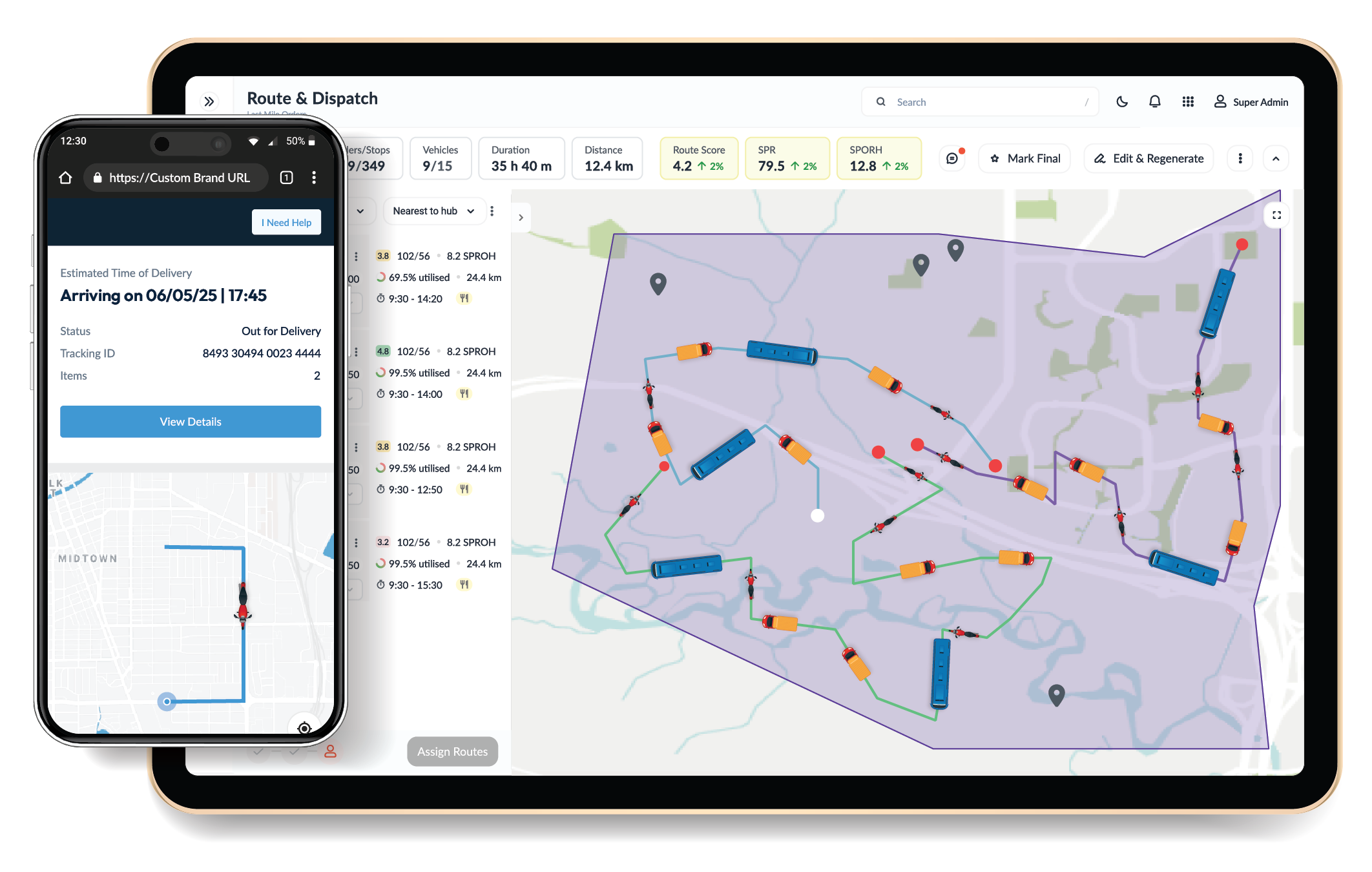- AI Route
Why AI Route Planning is Becoming the Standard for Scalable Delivery Operations
Table of Contents
- The Day-to-Day Reality Dispatchers Must Tame
- What Makes AI Route Planning Fundamentally Different
- How an AI Route Planner Strengthens Planning, Execution, and Service
- Mini Case Snapshots That Mirror Daily Decisions
- Where Route Planning Software Fits Inside Your Technology Stack
- Why FarEye Aligns With Enterprise-Scale Routing Needs
- Capability Highlights You Can Put to Work Immediately
- Buyer Checklist for Route Optimization Software That Scales
- Putting AI Routing to Work the Way Dispatchers Actually Operate
- Ready to See AI Route Planning at Enterprise Depth

AI route planning sets the day up for success when orders surge, drivers clock in and customers expect reliable doorstep experiences. You feel that pressure each morning as volumes shift, windows tighten and exceptions queue before coffee cools.
One structural tailwind keeps raising the bar for routing performance across categories and service promises. The U.S. Census Bureau reports e-commerce represented 16.3% of retail sales in Q2 2025, underscoring persistent delivery intensity and variability.

That demand translates into multi-stop density, unpredictable dwell times and constrained curb access during busy hours. You need more than traditional sequences that crumble when reality intervenes. A system that learns, re-optimizes and protects service when five constraints change at once. Equally important is having clarity for drivers, transparency for customers and budget control for leadership.
This is where modern AI routing moves from a helpful tool to an operating standard today.
The Day-to-Day Reality Dispatchers Must Tame
You manage late order injections, conflicting time windows and vehicle capacity rules while balancing cost and service commitments. At the same time, you fight urban congestion, access restrictions, seasonal surges and staffing gaps that strain coverage models and driver morale.
You also reconcile inventory readiness with route viability, especially when split shipments and returns complicate loading logic. The consequence is avoidable miles, missed slots, frustrated customers and creeping cost per drop that leadership challenges weekly.
What Makes AI Route Planning Fundamentally Different
AI route planning ingests live conditions, historical patterns and business constraints, then continuously recomputes the next best plan for outcomes. You gain decisions that respect rules you care about, not just simplified distance reductions that ignore your operations. The system considers service times, compliance limits and territory balance while scoring millions of scenario branches quickly.
It learns true stop durations, localized traffic rhythms and building-level access quirks, then hardens those learnings into tomorrow’s plan. You receive credible ETAs, resilient sequences and higher first-attempt success because intelligence sits inside the routing core.
How an AI Route Planner Strengthens Planning, Execution, and Service
Every operation benefits when the same intelligence plans are made before dispatch, adapted during runs and fed improvements afterward.
Planning That Reduces Guesswork and Protects Budgets
You start with demand shaping that steers customers into efficient windows without harming convenience or satisfaction. The engine builds territories that minimize crisscrossing while preserving driver familiarity and realistic work content.
It also models vehicle constraints, cold-chain needs and loading ergonomics that matter when schedules are tight. You launch routes aligned to service goals, then buffer risk intelligently where demand volatility threatens commitments and cost.
Execution that Adapts to Reality Instead of Breaking
Mid-route changes arrive from traffic, cancellations, late picks and sudden priority orders demanding careful insertion. Your AI routing engine recalculates quickly, shuffling stops while honoring door codes, building hours and carrier constraints.
Drivers receive updated manifests that actually reduce confusion rather than adding cognitive noise at the curb. Exceptions move through defined playbooks that elevate only the decisions needing human judgment and customer context.
Service That Earns Trust with Accurate, Proactive Communication
Accurate ETAs, live tracking and reliable time windows reinforce customer confidence across home and business addresses. Your team sends updates that anticipate issues, not apologies after friction has already damaged the relationship.
Post-delivery proof flows cleanly into systems, supporting analytics, claims and continuous improvement cycles efficiently. You create a dependable cadence of promises kept, which strengthens repeat behavior and wallet share steadily.
Mini Case Snapshots That Mirror Daily Decisions
Grounded examples help show how AI route planning behaves under realistic constraints that your teams recognize instantly.
Same-Day Grocery Within Tight Evening Windows
You must deliver perishables between five and eight while school traffic and local events disrupt arterial flows. The engine clusters micro-territories, reserves slack for known bottlenecks and sequences stops around building elevator schedules. When a substitution delays loading on one tote, the plan reflows, saving the route without overtime or rebates.
Big-and-Bulky Appointments With Two-Person Crews
Your white-glove teams face stair restrictions, assembly time variability and strict building service hours. The planner learns true dwell times by item category and home configuration, then sizes crews to prevent downstream delays. When a customer reschedules midday, the engine recomputes, preserving two other appointments and keeping overtime contained.
Regional B2B Replenishment With LTL Constraints
You balance pallet counts, driver hours rules and warehouse cutoffs while meeting contract SLAs. The engine co-mingles freight intelligently, designs multi-day sequences and picks breakpoints that simplify next-morning departures. When a supplier pushes one pallet late, the plan re-balances loads without sacrificing primary customer commitments.
Where Route Planning Software Fits Inside Your Technology Stack
A credible platform sits between order capture and proof of delivery, connecting upstream and downstream systems reliably. You want integrations with TMS, WMS, OMS and carrier networks that prevent manual rekeying and duplicate truth. At the same time, you also want a routing core that understands EV range, charging stops and emissions goals without complex spreadsheets.
That architecture should expose APIs for planning, optimization, status and analytics while supporting enterprise security standards. You then feed telemetry back into the engine so tomorrow’s route plans benefit from yesterday’s field realities.
Why FarEye Aligns With Enterprise-Scale Routing Needs
FarEye’s Route Planning Software places AI route planning at the center of planning, execution and experience layers. The platform provides real-time dynamic optimization, a proprietary AI-powered routing algorithm and deep constraint handling tuned for enterprise operations.
You can prioritize EV and green fleets, include charging locations and align route decisions with sustainability targets deliberately. A unified control tower integrates with TMS, WMS and carrier systems to reduce swivel-chair work and reconciliation effort.
Territory planning, hyperlocal and same-day routing and scheduled big-and-bulky flows live within one coherent platform. Those capabilities matter most when volumes spike, windows compress and exceptions threaten cost and customer experience together.
Capability Highlights You Can Put to Work Immediately
You can model driver rosters, DOT rules and capacity types across owned, hybrid and outsourced fleets without losing control. Further, you can factor promised ETAs into planning rather than bolting messaging onto brittle stop sequences after dispatch.
You can broadcast orders to nearby drivers, orchestrate dynamic allocation and balance pay equity across hyperlocal zones thoughtfully. At the same time, you can leverage a routing API to embed optimization inside existing systems while retaining specialized business logic safely. These features combine to deliver fewer empty miles, better stop density and credible ETAs that stand up under load.
Buyer Checklist for Route Optimization Software That Scales
Every enterprise selects routing differently, yet several criteria consistently separate durable platforms from tactical tools.
- Multi-objective optimization that respects real constraints. Your engine should balance SLAs, capacity, compliance and emissions instead of chasing shortest-path proxies.
- Learning loops that actually improve plans weekly. Your platform must capture true dwell times, micro-traffic patterns and access quirks without manual cleanup work.
- Re-optimization speed when reality shifts unexpectedly. Your team needs sub-minute replans that preserve commitments and avoid overtime when inserts arrive late.
- Tight integrations and clean data contracts. Your stack deserves APIs, webhooks and event streams that eliminate spreadsheets and fragile handoffs between systems.
- Driver experience that removes friction. Your drivers need clear manifests, smart sequencing and proactive updates when plans change mid-route, not fixed PDFs.
- Customer transparency with reliable ETAs. Your customers deserve accurate windows, responsive updates and proof artifacts that resolve questions before they escalate.
- EV-aware and sustainability-ready routing. Your playbook should include charging stops, range edges and emissions reporting that leadership can trust for goals.
- Security, governance and scalability. Your organization requires compliance controls, role-based access and elastic capacity for seasonal peaks without manual triage.
- Operational intelligence beyond maps. Your team benefits from dashboards explaining “why this route is optimal,” not black boxes that frustrate continuous improvement.
- Extensible routing API for bespoke workflows. Your engineers should embed optimization into unique flows without abandoning proven enterprise platforms immediately.
Putting AI Routing to Work the Way Dispatchers Actually Operate
You will still make judgment calls, mentor new drivers and negotiate impossible windows with empathy and pragmatism daily. AI route planning does not replace that experience; it amplifies it by removing noise and surfacing true tradeoffs quickly. You gain the minutes required to coach, communicate and stabilize service before issues become refunds or churn.
You also gain a defensible operating rhythm that leadership recognizes in weekly reviews and financial outcomes consistently. The standard emerges not from buzzwords, but from measurable resilience when situations turn difficult and costs threaten margins.
Ready to See AI Route Planning at Enterprise Depth
If you are assessing route planning software, FarEye merits a close look today. You can evaluate AI routing, machine learning improvements and integration depth inside your live workflows without organizational whiplash.
At the same time, you can validate driver experience, exception handling and ETA credibility under your real constraints and service commitments quickly. Ready to scale parcel delivery without breaking operations? Request a demo to see how FarEye improves routing, capacity and cost control.
Source:
Monthly Retail Trade - Quarterly Retail E-Commerce Sales Report

Komal Puri is a seasoned professional in the logistics and supply chain industry. As the AVP of Marketing and a subject matter expert at FarEye, she has been instrumental in shaping the industry narrative for the past decade. Her expertise and insights have earned her numerous awards and recognition. Komal’s writings reflect her deep understanding of the industry, offering valuable insights and thought leadership.
Let's Talk to Our Experts and Optimize Your Deliveries Today!
An expert from our team will reach out within 24 hours
Related resources


